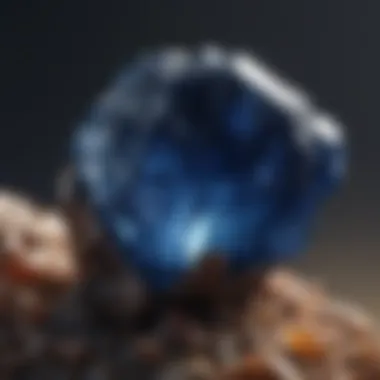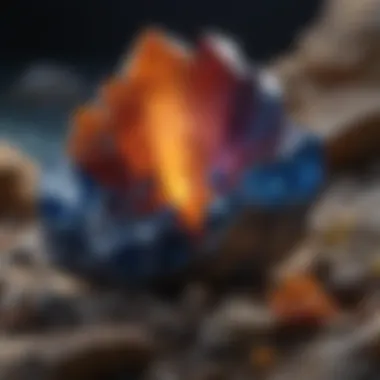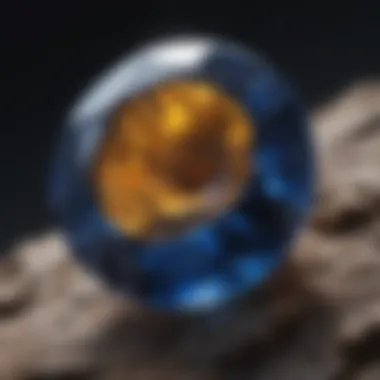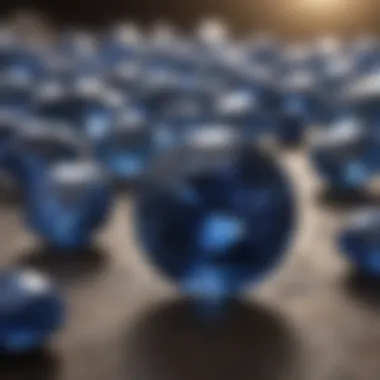Exploring the Intricacies of Raw Sapphire Gems


Intro
Raw sapphire, an often overlooked gemstone, holds considerable intrigue for collectors and enthusiasts alike. Its geological formation, unique characteristics, and myriad applications provide a rich tapestry for exploration. Understanding the formation process of raw sapphire is crucial, as it offers insights into its intrinsic value and significance. In addition, the cultural importance of this gemstone cannot be understated, with its historical ties and representation in various societies across the globe. Collectors are not only drawn to its beauty but also to the story behind its existence.
This article will delve into the multifaceted world of raw sapphire, examining its geological roots, unique traits, cultural significance, market dynamics, and future within both natural and synthetic contexts. By the end, readers will have a comprehensive view of raw sapphire that balances scientific insight with practical knowledge for collectors.
Rock and Fossil Identification
When it comes to raw sapphire, identifying its various characteristics can greatly enhance a collector's understanding of the gemstone.
Types of Sapphires
- Natural Sapphire: Formed through geologic processes, typically found in alluvial deposits.
- Synthetic Sapphire: Created in laboratories, mimicking the conditions under which natural sapphires form.
- Fancy Sapphire: A category that includes sapphires in colors other than blue, such as pink and yellow.
Characteristics to Look For
When examining raw sapphires, certain traits are essential:
- Color Intensity: The depth of color significantly affects value.
- Clarity: Fewer inclusions usually indicate higher quality.
- Cut and Shape: The way the sapphire is cut can enhance its beauty and value.
Tools for Identification
Collectors should equip themselves with the proper tools. Essential items include:
- Loupe or Microscope: For inspecting clarity and inclusions.
- Refractometer: To measure refractive index and assist in identification.
- Scale: For precise weight measurements.
Geological Insights
Understanding the geological aspects of raw sapphire contributes to a deeper appreciation of its significance.
Geological Formations and Processes
Sapphire primarily forms in metamorphic rock types, such as gneiss and schist. The transformation of aluminum-rich minerals under high temperature and pressure conditions leads to the crystallization of sapphire. Alluvial deposits are another primary source, where natural weathering processes wash sapphires from their original locations.
Historical Significance
Sapphires have been cherished for centuries. They have appeared in ancient royal families' adornments, believed to symbolize wisdom, loyalty, and nobility. Historically notable discoveries emphasize this gemstone's enduring appeal.
Notable Discoveries in the Field
Some remarkable sites include the Kashmir mines in India, known for their vivid blue sapphires, and the Australian fields, which are famed for their beautiful natural settings. Each location adds to the narrative of raw sapphires, enhancing their allure.
Collecting Tips and Techniques
Engaging in sapphire collecting requires a blend of strategy and passion. Here are important tips:
Best Practices for Collecting
- Research: Understanding market trends will lead to educated buying decisions.
- Networking: Consider joining gem and mineral clubs.
- Ethics: Prioritize ethical sourcing and conservation.
Locating Prime Collecting Sites
Many sapphire-rich locations exist, such as:
- The Yogo Gulch in Montana, USA
- The sapphirine regions of Sri Lanka
Knowing where to search enhances the chance of finding quality specimens.
Safely Extracting Specimens
Proper techniques matter when extracting raw sapphires:


- Use Hand Tools: Avoid heavy machinery to minimize damage.
- Choose Optimal Timing: Weather can affect site accessibility, making seasonal planning crucial.
Preservation and Display
Once acquired, raw sapphires need care for maintaining their beauty and integrity.
Techniques for Preserving Rocks and Fossils
- Cleaning: Gently clean specimens with water and a soft brush.
- Avoid Harsh Chemicals: This helps prevent degradation.
Proper Storage Methods
Ensure sapphires are stored in suitable conditions:
- Use padded boxes or silky cloths to avoid scratches.
- Store them in a controlled environment to minimize temperature fluctuations.
Creative Display Ideas
- Consider using glass display cases to show off the sapphires while protecting them.
- Group them with complimentary stones for an attractive presentation.
These steps not only preserve the beauty of raw sapphires but also enhance their value, reflecting a collector's dedication to their passion.
Understanding these aspects of raw sapphire lays the groundwork for a more profound appreciation of this precious gemstone and its place in our natural world.
Prelims to Raw Sapphire
Raw sapphire, a dazzling variety of corundum, offers a window into the Earth’s geological processes, aesthetic values, and historical contexts. Understanding raw sapphire is paramount for both collectors and enthusiasts who seek to appreciate not only its beauty but also its profound significance. In this section, we will unravel the fundamental attributes that define this gemstone, and explore the historical context that frames its status in various cultures.
Definition and Characteristics
Raw sapphire is characterized by its hardness, typically scoring a 9 on the Mohs scale, making it one of the toughest gemstones. This durability adds to its desirability as a material for jewelry and industrial applications. The color of sapphire can vary widely; while many associate the stone with a vivid blue hue, it can also occur in shades of yellow, pink, green, and even colorless forms. This versatility is essential in understanding its value in different markets.
Sapphires often contain inclusions, which are internal characteristics that manifest as tiny imperfections. These inclusions can reveal important information about the sapphire's origin and formation. The presence of specific inclusions can even enhance the value of a raw sappire, as they can contribute to its unique story. Moreover, raw sapphires are often valued by their size and weight, measured in carats. Larger stones with fewer inclusions tend to draw higher prices.
Historical Context of Sapphire
The allure of sapphire is steeped in history, tracing back thousands of years. Ancient civilizations viewed this mineral not just as an ornament, but also as a talisman of protection and power. The Babylonian priests prized these stones, believing they to be connected to the divine. Many cultures have regarded sapphires as symbols of wisdom and nobility. For instance, during the Middle Ages, the stones were worn by European royalty and clergy as they were thought to bring favor from God.
Interestingly, sapphire's historical use extends beyond adornment. In the past, it was often ground into powder and used in various remedies. Some healing practices linked sapphire to the enhancement of marital harmony or the alleviation of sleeplessness. This multifaceted historical significance illustrates the gemstone's pervasive role throughout time and across cultures.
"Sapphire has been revered not only for its beauty but also for its historical and cultural implications throughout the ages."
Through a clear understanding of what defines raw sapphire and its rich past, collectors can appreciate the complexities behind each stone they encounter. This grounding will serve as a foundation for delving deeper into its geological formation and physical properties.
Geological Formation
The geological formation of raw sapphire is a fundamental aspect of understanding this precious gemstone. It involves various processes that lead to the creation of sapphire deposits. Understanding these processes is essential for rock and fossil collectors as it not only provides insight into the origins of sapphire but also impacts the market trends and conservation strategies surrounding this stone. In this section, we will explore how sapphires form, where they are mined, and the geological characteristics of their deposits.
Sapphire Formation Process
Sapphires are primarily composed of corundum, an aluminum oxide. They typically form within metamorphic rocks under high-pressure and high-temperature conditions. The formation process includes:
- Metamorphism: Existing aluminum-rich rocks, like basalt, transform into corundum through heat and pressure over time.
- Crystallization: As the temperature rises, corundum crystallizes, resulting in various colors and qualities, influenced by minerals like iron and titanium during the process.
- Weathering and Erosion: Natural processes of weathering can transport sapphires from their original sites, depositing them in secondary locations like riverbeds and alluvial plains.
This unique cycle not only leads to varied characteristics among sapphires but also defines the quality of the stones. Understanding these stages offers collectors valuable context about their specimens.
Mining Locations of Raw Sapphire
Sapphire is mined in several locations around the world, each contributing distinct geological attributes. Key mining sites include:
- Myanmar (Burma): Renowned for its high-quality blue sapphires.
- Sri Lanka: Known for producing a wide range of colored sapphires, including the famous Ceylon sapphires.
- Australia: Home to some of the largest sapphires, particularly in Queensland.
- Montana, USA: Produces unique Montana sapphires known for their pastel colors.
Each location offers minerals and environmental conditions that affect the final appearance and quality of the sapphires. Collectors often seek to trace the origins of their gems to understand these differences and enhance their appreciation of the stones.


Geological Characteristics of Deposits
The geological characteristics of sapphire deposits can greatly influence their market value. Factors include:
- Depth of Formation: Deeper deposits often yield higher-quality stones due to prolonged geological processes.
- Type of Host Rock: The underlying rock can significantly affect the sapphire's quality, with certain rocks, like gneiss and schist, being more favorable.
- Gem Quality versus Industrial Quality: Not all sapphires are gem-quality; many are mined for industrial uses. Understanding the differences is vital for collectors to assess value.
These characteristics not only contribute to the intrinsic value of sapphires but also inform ethical and sustainable mining practices that are increasingly important in today’s market.
Understanding the geological formation of raw sapphire helps collectors appreciate the intricate history behind each stone, enhancing both their collecting experience and the ethical considerations of their purchases.
Physical and Chemical Properties
The study of physical and chemical properties of raw sapphire is crucial in understanding its overall value and characteristics. The properties not only define the gemstone but also contribute to its desirability among collectors and jewelers. By examining the crystallographic structure, color variations, and clarity, one can gain important insight into the quality and authenticity of sapphire.
Crystallographic Structure
Raw sapphire primarily consists of corundum, an aluminum oxide crystal. This particular crystallographic structure features a hexagonal system, which plays a significant role in the sapphire's durability. The hardness of sapphire is rated at 9 on the Mohs scale, making it one of the hardest gemstones available. This hardness means that sapphire can withstand scratches and wear, which is vital for both jewelry and industrial applications.
The well-defined crystal system contributes to the optical phenomena observed in sapphires. For instance, a well-formed crystal can reflect light beautifully, leading to a more vibrant appearance. Furthermore, the internal structure affects how light interacts with the stone, influencing the overall aesthetic appeal.
Color Variations and Their Significance
The color of raw sapphire can range from traditional blue to a broad spectrum that includes yellow, pink, green, and even colorless varieties. Each color is attributed to unique trace elements; for instance, iron and titanium are responsible for blue sapphires, while chromium offers a pink hue. The significance of color in sapphire goes beyond mere aesthetics; it impacts market value greatly. Blue sapphires command higher prices, especially those with a deep, vivid tone and good saturation.
Moreover, color plays a pivotal role in a collector's decision-making process. Certain colors may hold cultural or personal significance, thereby further enhancing their value. Hence, understanding these variations is essential for anyone interested in collecting or investing in sapphires.
Clarity and Inclusions
Clarity refers to the presence of internal features or 'inclusions' within a gemstone. Raw sapphires may contain various inclusions, which can be natural, like rutile needles, or man-made. Higher clarity is generally more desirable in gemstones, as it indicates a cleaner, more pristine appearance.
However, some inclusions can add character and uniqueness. They may provide a sapphire with a distinct identity, setting it apart from others on the market. Identifying inclusions requires expertise; therefore, a trained gemologist often evaluates raw stones to assess their clarity and overall quality.
In summary, the physical and chemical properties of raw sapphire are fundamental to its identity, marketability, and desirability. Understanding these aspects enhances one's appreciation for this captivating gemstone.
Cultural and Symbolic Significance
The cultural and symbolic significance of sapphire transcends its physical beauty.Throughout history, this gemstone has been integrated into various societal frameworks and belief systems, often serving as a powerful symbol of status, devotion, and protection. Its rich hues and perceived mystical properties have resonated with different civilizations around the world, adding layers to the understanding of sapphire beyond its aesthetic appeal. Collectors often seek sapphires not only for their beauty but also for the stories and meanings attached to them.
Additionally, its longstanding popularity in royal jewelry reinforces the connection between sapphires and wealth, authority, and divine favor. The lasting relevance of sapphire in cultural contexts speaks to its durability, connecting the past with the present.
Sapphire in Various Cultures
Sapphire's influence varies considerably across cultures, each attributing unique meanings to this blue gemstone. In ancient Persia, for example, it was believed the earth rested on a giant sapphire, reflecting its blue hue in the sky. This idea tied the stone to stability and celestial protection. In medieval Europe, sapphires were associated with heaven, representing truth and fidelity. This narrative even extended to marriages, with many couples opting for sapphire engagement rings to symbolize loyalty.
Moreover, in Hinduism, sapphire is connected with the planet Saturn and is considered auspicious for those who seek blessings for health and wealth. In contrast, Islamic cultures view sapphires as a protective stone against malevolent forces. These diverse cultural interpretations enhance the allure of sapphire for collectors, making it a significant focal point in gemology.
Myths and Legends Surrounding Sapphire
Sapphire's allure has spawned numerous myths and legends throughout history. Each tale showcases its mystical properties and reinforces its esteemed position among gemstones. One notable legend involves the origins of the sapphire itself. It is said that the vibrant blue sapphire was formed under the divine influence of the gods. Ancient tales often depict sapphire as either a heavenly gift or a stone of protection, ensuring the wearer safety from harm.
Another intriguing myth revolves around the idea that wearing a sapphire can confer wisdom and enlightenment. This belief has driven its use in religious and royal contexts, where rulers and spiritual leaders sought to imitate the divine qualities attributed to the gemstone.
In contemporary times, these historical narratives continue to impact the market, influencing both the valuation and desirability of sapphires among collectors and enthusiasts.
Market Trends and Valuation
Market trends and valuation are critical when it comes to raw sapphire. Understanding these trends can help collectors and investors make informed decisions. These factors influence not only the pricing of raw sapphires but also their availability and desirability in the market. The dynamics of supply, demand, and consumer preferences shape the future landscape of this precious gemstone.
Market Overview of Sapphire
The global market for raw sapphire has been fluctuating in recent years. Historically, sapphires have held significant value, often driven by demand from jewelry makers. In recent times, however, the market has seen more interest from collectors and investors. The rise of e-commerce has also played a role. Online platforms allow broader accessibility, making it easier for buyers to find rare stones, thus expanding the market.
The sources of rough sapphires are primarily located in regions like Sri Lanka, Madagascar, and Australia. Each location provides unique characteristics that impact overall valuation. In particular, the demand for ethically sourced sapphires is rising. Buyers are increasingly concerned about the environmental impact of mining practices.


Valuation Factors for Raw Sapphire
Several factors influence the valuation of raw sapphires. These include:
- Color: The hue of a sapphire significantly affects its value. Rich blue sapphires tend to fetch the highest prices, while lighter tones might be less valued.
- Clarity: The internal and external quality of a gemstone is crucial. Inclusions or blemishes can reduce value significantly.
- Size: Larger sapphires are rarer and generally more valuable than smaller stones. However, size alone does not determine value. Quality must also be considered.
- Origin: The provenance of a sapphire, particularly if it comes from a well-known region, can enhance its market value.
These factors must be analyzed carefully. Collectors should assess each stone individually to make informed decisions based on these criteria.
Impact of Synthetic Alternatives
The introduction of synthetic sapphires has altered the landscape of gem markets. Synthetic stones can replicate the appearance of natural sapphires while being more economically accessible. Many collectors and buyers may view synthetic stones with skepticism. However, some appreciate their affordability.
As synthetic sapphires become more prevalent, their impact on natural sapphire valuation must be considered. The existence of a synthetic alternative can depress the prices of natural stones if consumers perceive them as interchangeable. It is essential for collectors to differentiate between the two and understand their potential value in the current market.
"The rise of synthetic sapphires presents a unique challenge. While they offer affordability, understanding the intrinsic value of natural stones remains vital for collectors."
In summary, the market trends and valuation of raw sapphires are dynamic and influenced by various factors, including quality, origin, and the impact of synthetic alternatives. Awareness of these elements is crucial for anyone looking to navigate the complexities of sapphire collecting and investing.
Conservation and Ethical Considerations
The topic of conservation and ethical considerations surrounding the raw sapphire industry is critical. This section highlights the environmental challenges posed by sapphire mining and the need for sustainable practices. The extraction of sapphires is not without its consequences. The process can disrupt ecosystems, contribute to soil erosion, and lead to water contamination. Addressing these issues is essential for preserving both the gemstones and the environments in which they are found.
Sapphire Mining and Environmental Impact
Mining for raw sapphires often leads to various environmental degradation. In regions where sapphire deposits exist, there may be significant ecological changes. The removal of vegetation to access mining sites can result in habitat loss for local wildlife. This disturbance can create long-lasting effects on the biodiversity of these areas. Additionally, the use of chemicals in processing sapphires can contaminate nearby water sources, posing risks to local communities and wildlife. It is vital to recognize these effects and promote awareness regarding mining practices.
Key points regarding the environmental impacts of sapphire mining include:
- Habitat destruction: The excavation of mining sites destroys natural habitats for many species.
- Water pollution: Chemicals used in sapphire processing can leach into water systems.
- Soil erosion: Removing vegetation can lead to increased runoff and erosion.
- Air quality issues: Dust and emissions from mining activities can affect air quality in surrounding areas.
"The synergy between ethical sourcing and environmental care is essential for the future of raw sapphires."
To mitigate these impacts, a shift towards sustainable mining processes is necessary. Those involved in the sapphire industry must also consider their responsibilities to both their communities and the ecosystem.
Sustainable Sourcing Practices
Sustainable sourcing practices for sapphires involve obtaining gemstones in a way that minimizes environmental impact and supports local communities. Various guidelines can be employed to ensure ethical considerations are met. This includes monitoring mining conditions and ensuring fair labor practices.
Some sustainable practices include:
- Artisanal mining: Supporting local miners who use traditional and less harmful extraction methods can reduce environmental strain.
- Certification: Sourcing sapphires only from certified suppliers who adhere to environmental and social standards.
- Community engagement: Involving local communities in decision-making processes regarding mining operations to address their needs and concerns.
- Rehabilitation efforts: Implementing measures that restore mined areas to their original state after extraction ceases.
Incorporating these practices not only helps protect the environment but also enriches the ethical landscape of the sapphire market. Transparency and accountability within the supply chain are becoming increasingly important to buyers who value ethically sourced gemstones. Collectors and enthusiasts must be informed and support initiatives that promote sustainable practices.
Through understanding the connection between sapphire mining, environmental concerns, and ethical sourcing, stakeholders can contribute positively to the future of raw sapphires. This insight is crucial for recognizing the complexities of obtaining such a prized gemstone.
Future Prospects of Raw Sapphire
The future prospects of raw sapphire present an intricate landscape marked by evolving market dynamics, technological advancements, and growing consumer awareness. As the gemstone industry progresses, understanding these trends becomes essential for collectors and investors alike. The continuous interest in sapphires can be attributed to both their natural beauty and their multifunctional uses across various sectors.
Trends in Sapphire Usage
Sapphire is more than a traditional gemstone for jewelry. Its applications are diversifying in recent years. The increasing demand for high-quality blue sapphires and fancy colored varieties reflects changing consumer preferences.
- Jewelry: Sapphires are widely sought for engagement rings and other fine jewelry due to their durability and aesthetic appeal.
- Technology: The properties that make sapphire suitable for jewelry also lend themselves to technology. For instance, synthetic sapphires feature in modern electronic devices such as smartphones and watches, reinforcing their importance beyond aesthetics.
- Industrial Uses: Sapphire is gaining traction in industries like aerospace and medical due to its hardness and high-temperature resistance.
Emerging markets, especially in Asia and the Middle East, are also contributing significantly to the demand for sapphires. As awareness of the gemstone's versatility grows, collectors should monitor these trends closely for valuable insights.
Technological Innovations in Sapphire Processing
Technological advancements are reshaping the way raw sapphires are extracted, processed, and utilized. Innovations are making it easier and more efficient to work with this precious stone.
- Synthetic Sapphire Production: Recent developments in the production of synthetic sapphires have significantly impacted the market. The Czochralski and hydrothermal methods have made it feasible to create high-quality sapphires with minimal environmental disruption.
- Enhanced Cutting Techniques: New techniques in diamond-tipped cutting tools have improved how sapphires are cut and polished. This not only maximizes yield but also enhances clarity and color retention of the final product.
- 3D Printing: Innovations in 3D printing are introducing new applications for sapphires in diverse fields, including bespoke jewelry and precision components for various industries.
Overall, the future of raw sapphire lies in its adaptability and the innovations shaping its market. As technology and consumer preferences continue to evolve, the path for sapphire in both natural and synthetic forms looks promising.
"The combination of traditional craftsmanship and new technologies is key to unlocking the full potential of sapphire in the modern marketplace."
By understanding these future prospects, rock and fossil collectors can enrich their knowledge and better navigate the complexities of collecting and investing in sapphires.







